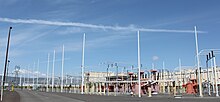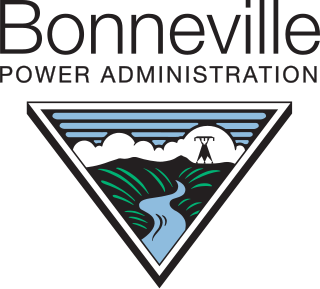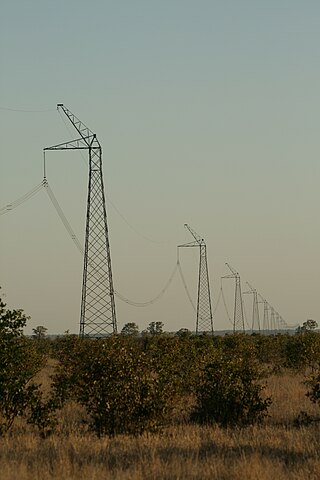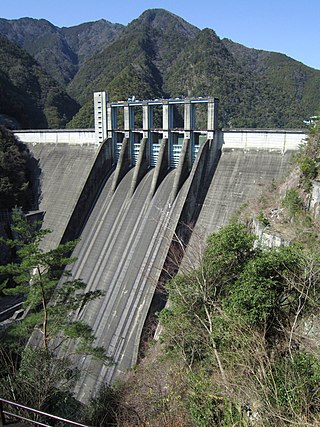

The Celilo Converter Station, built in 1970 and owned and operated by the Bonneville Power Administration, is the northern terminus of the Pacific DC Intertie, near The Dalles, Oregon, in the United States.


The Celilo Converter Station, built in 1970 and owned and operated by the Bonneville Power Administration, is the northern terminus of the Pacific DC Intertie, near The Dalles, Oregon, in the United States.
The Celilo Converter Station was originally configured with six groups of six-pulse mercury arc valves with a blocking voltage of 133 kV each (for a total of ±400 kV) and a maximum current of 2,000 amperes. [1] [2]
There was also a DC test facility for testing high voltage equipment nearby (now abandoned, soon to be demolished). At the end of the 1960s, a test transmission line for 1,333 kV was erected at 45°28′58″N120°48′51″W / 45.482792°N 120.814097°W . The facility was built to test the high voltage DC equipment [5] intended for a planned connection between Celilo Converter Station and Hoover Dam that never was built.[ citation needed ]

A high-voltage direct current (HVDC) electric power transmission system uses direct current (DC) for electric power transmission, in contrast with the more common alternating current (AC) transmission systems.

The Bonneville Power Administration (BPA) is an American federal agency operating in the Pacific Northwest. BPA was created by an act of Congress in 1937 to market electric power from the Bonneville Dam located on the Columbia River and to construct facilities necessary to transmit that power. Congress has since designated Bonneville to be the marketing agent for power from all of the federally owned hydroelectric projects in the Pacific Northwest. Bonneville is one of four regional Federal power marketing agencies within the U.S. Department of Energy (DOE).
The HVDC Volgograd–Donbass is a 475 kilometres (295 mi) long bipolar ±400 kV high voltage direct current powerline used for transmitting electric power from Volga Hydroelectric Station at Volgograd in Russia to Donbas in eastern Ukraine and vice versa.
The HVDC Inter-Island link is a 610 km (380 mi) long, 1200 MW high-voltage direct current (HVDC) transmission system connecting the electricity networks of the North Island and South Island of New Zealand together. It is commonly referred to as the Cook Strait cable in the media and in press releases, although the link is much longer than its Cook Strait section. The link is owned and operated by state-owned transmission company Transpower New Zealand.

The Pacific DC Intertie is an electric power transmission line that transmits electricity from the Pacific Northwest to the Los Angeles area using high voltage direct current (HVDC). The line capacity is 3.1 gigawatts, which is enough to serve two to three million Los Angeles households and represents almost half of the Los Angeles Department of Water and Power (LADWP) electrical system's peak capacity.

The Nelson River DC Transmission System, also known as the Manitoba Bipole, is an electric power transmission system of three high voltage, direct current lines in Manitoba, Canada, operated by Manitoba Hydro as part of the Nelson River Hydroelectric Project. It is now recorded on the list of IEEE Milestones in electrical engineering. Several records have been broken by successive phases of the project, including the largest mercury-arc valves, the highest DC transmission voltage and the first use of water-cooled thyristor valves in HVDC.
HVDC Kingsnorth was a high-voltage direct-current (HVDC) transmission system connecting Kingsnorth in Kent to two sites in London. It was at one time the only application of the technology of high voltage direct current transmission for the supply of transformer stations in a city, and the first HVDC link to be embedded within an AC system, rather than interconnecting two asynchronous systems. It was also the first HVDC scheme to be equipped with self-tuning harmonic filters and to be controlled with a "Phase Locked Oscillator", a principle which subsequently became standard on all HVDC systems.

Cahora-Bassa is an HVDC power transmission system between the Cahora Bassa Hydroelectric Generation Station at the Cahora Bassa Dam in Mozambique, and Johannesburg, South Africa.

The Inga–Shaba EHVDC Intertie is a 1,700 kilometres (1,100 mi)-long high-voltage direct current overhead electric power transmission line in the Democratic Republic of Congo, linking the Inga hydroelectric complex at the mouth of the Congo River to mineral fields in Shaba (Katanga). It was primarily constructed by Morrison-Knudsen International, an American engineering company, with the converter equipment supplied by ASEA. Construction was completed in 1982 and it cost US$900 million. The scheme was, for many years, the longest HVDC line in the world.

An HVDC converter station is a specialised type of substation which forms the terminal equipment for a high-voltage direct current (HVDC) transmission line. It converts direct current to alternating current or the reverse. In addition to the converter, the station usually contains:

A valve hall is a building which contains the valves of the static inverters of a high-voltage direct current plant. The valves consist of thyristors, or at older plants, mercury arc rectifiers. Mercury arc rectifiers are usually supported by insulators mounted on the floor, while thyristor valves may be either supported by insulators or hung from the roof of the valve hall. The latter required a stronger ceiling structure, however the hall and the static inverter can better survive earthquakes compared to valve structures standing on the floor.
The HVDC Itaipu is a High-voltage direct current overhead line transmission system in Brazil from the Itaipu hydroelectric power plant to the region of São Paulo. The project consists of two ±600 kV bipoles, each with a rated power of 3150 MW, which transmit power generated at 50 Hz from the Paraguay side of the Itaipu Dam to the Ibiúna converter station near São Roque, São Paulo. The system was put in service in several steps between 1984 and 1987, and remains among the most important HVDC installations in the world.

Shin-Shinano Frequency Converter is the designation of a back-to-back high-voltage direct current (HVDC) facility in Japan which forms one of four frequency converter stations that link Japan's western and eastern power grids. The other three stations are at Higashi-Shimizu, Minami-Fukumitsu, and Sakuma Dam.
The HVDC Rihand–Delhi is a HVDC connection between Rihand and Dadri in India, put into service in 1990. It connects the 3,000 MW coal-based Rihand Thermal Power Station in Uttar Pradesh to the northern region of India. The project has an 814 kilometres (506 mi) long bipolar overhead line. The transmission voltage is 500 kV and the maximum transmission power is 1,500 megawatts. The project was built by ABB.
The Sylmar Converter Station is the southern converter station of the Pacific DC Intertie, an electric power transmission line which transmits electricity from the Celilo Converter Station outside The Dalles, Oregon to Sylmar, a neighborhood in the northeastern San Fernando Valley region of Los Angeles, California. The station converts the 500 kV direct current coming from the northern converter station Celilo to alternating current at 60 Hz and 230 kV synchronized with the Los Angeles power grid. The station capacity is 3,100 megawatts. It is jointly owned by two electric utility providers, Southern California Edison and Los Angeles Department of Water and Power.

The Sakuma Dam is a dam on the Tenryū River, located on the border of Toyone, Kitashitara District, Aichi Prefecture on the island of Honshū, Japan. It is one of the tallest dams in Japan and supports a 350 MW hydroelectric power station. Nearby a frequency converter station is installed, allowing interchange of power between Japan's 50 Hz and 60 Hz AC networks.
The Moscow–Kashira HVDC transmission system was an early high-voltage direct current (HVDC) connection between the town of Kashira and the city of Moscow in Russia, where the terminal was at 55°39′32″N37°38′16″E. The system was built using mercury-arc valves and other equipment removed from the Elbe Project in Berlin at the end of World War II. Although primarily experimental in nature, the system was the first true static, electronic, high-voltage DC scheme to enter service. Earlier DC transmission schemes had either used electromechanical converters based on the Thury system, such as the Lyon–Moutiers DC transmission scheme or had been at only medium voltage, such as the 12 kV frequency converter scheme at Mechanicville, New York in the United States.
An HVDC converter converts electric power from high voltage alternating current (AC) to high-voltage direct current (HVDC), or vice versa. HVDC is used as an alternative to AC for transmitting electrical energy over long distances or between AC power systems of different frequencies. HVDC converters capable of converting up to two gigawatts (GW) and with voltage ratings of up to 900 kilovolts (kV) have been built, and even higher ratings are technically feasible. A complete converter station may contain several such converters in series and/or parallel to achieve total system DC voltage ratings of up to 1,100 kV.
The Xiangjiaba–Shanghai HVDC system is a ±800 kV, 6400 MW high-voltage direct current transmission system in China. The system was built to export hydro power from Xiangjiaba Dam in Sichuan province, to the major city of Shanghai. Built and owned by State Grid Corporation of China (SGCC), the system became the world’s largest-capacity HVDC system when it was completed in July 2010, although it has already been overtaken by the 7200 MW Jinping–Sunan HVDC scheme which was put into operation in December 2012. It also narrowly missed becoming the world’s first 800 kV HVDC line, with the first pole of the Yunnan–Guangdong project having been put into service 6 months earlier. It was also the world’s longest HVDC line when completed, although that record is also expected to be overtaken early in 2013 with the completion of the first bipole of the Rio Madeira project in Brazil.

The Juan de Fuca Cable Project is a proposed 550 MW, 150 kV high-voltage direct current (HVDC) submarine power cable connection running 19 miles (31 km) under the Strait of Juan de Fuca between Port Angeles, Washington, and Victoria, British Columbia. The project's final environmental impact statement was completed in October 2007, and a presidential permit issued in June 2008.